Exploring topics as diverse as contemporary feminism, OCD and cycling, this talented LCC graduate uses grids and geometric shapes to convey complex ideas.

How would you describe your approach to design?
Generally my work has a lot going on. I don't know if I would use the word playful, but I try to make my compositions interesting and appealing through the use of lots of different elements and structures simultaneously. Lately, my process begins by trying to translate ideas and concepts into shapes. Sometimes abstract shapes, some other times figurative ones. I enjoy using basic geometric shapes because they can end up being whatever I want them to be, and the iteration of these with figurative shapes, images or type gives me enough material to play around with. I'm also a big fan of the grid and tend to include it as an extra graphic element in the design.
Regarding the technical part, I almost always design in black and white and add colour in a middle or late stage. This could be because my work is more linear or 2D, although I do use a lot of colour.












Can you tell us a little bit about how you use diagrams in your work?
The whole diagram aesthetic started for two main reasons: the first one is my love for the grid. As I mentioned previously, I like to include the grid as part of the design in some cases and I guess that structure already makes something look like a diagram. The second reason is the need to distract myself. I am a really anxious person and if I don't make it stop my mind will just wander and not in a good way. I realised that designing intricate or busy visual compositions make me really focus on balance, space, and the relation between the elements. Finding 'the right' place for each element in the space takes time and concentration, especially when you have lots of elements working together.












Talk us through the research and design process behind On Complexity and Depth. What did you want to achieve?
On Complexity and Depth was my final project for my MA. I chose to work on the topic of Obsessive Compulsive Disorder since mental health is an issue I am really interested in. This is a really complex disorder that presents itself in a person in very different ways throughout their lives and can also vary from mild to extremely severe. Although I worked with particular examples of the condition to make the publications less abstract and more engaging, I did pin down a number of elements that can be seen throughout every type of OCD.
My aim was to see whether it was possible to communicate through graphic design the abstract and complex concepts that characterise OCD. Even though people in the UK today are beginning to speak more about mental health than they have in the past, I still find the approach of certain charities and organisations victimising and a bit tragic. I thought that through my design project I could talk about these issues from somewhere other than theory and facts, and I could add a different perspective to the ongoing conversation.




You’ve created quite a few publications, covering topics as diverse as contemporary feminism and cycling. What do you think makes a well-designed book or magazine?
I guess it depends on what the publication is, the subject, the audience, etc. but generally, I think that no matter what the content is, a designer can always find a way to make a publication stand by itself – either through materials, binding, texture, format, and concept. Personally I like to make publications that include many different layouts and formats; I enjoy rhythm and change, otherwise I get bored. The challenge is then making these different elements into a solid piece of design.



Where would you like to be in ten years?
I think my main goal is to be able to work on projects with topics that are important to me. What I'd like to do is to be able to say no to things I don't find interesting and yes to projects that I think will contribute positively to society, even in the slightest. I tried doing this when I was in university (the project on feminism and on OCD were both made during my postgraduate studies) but I find it harder in real, commercial life.
ceciliaserafini.com

